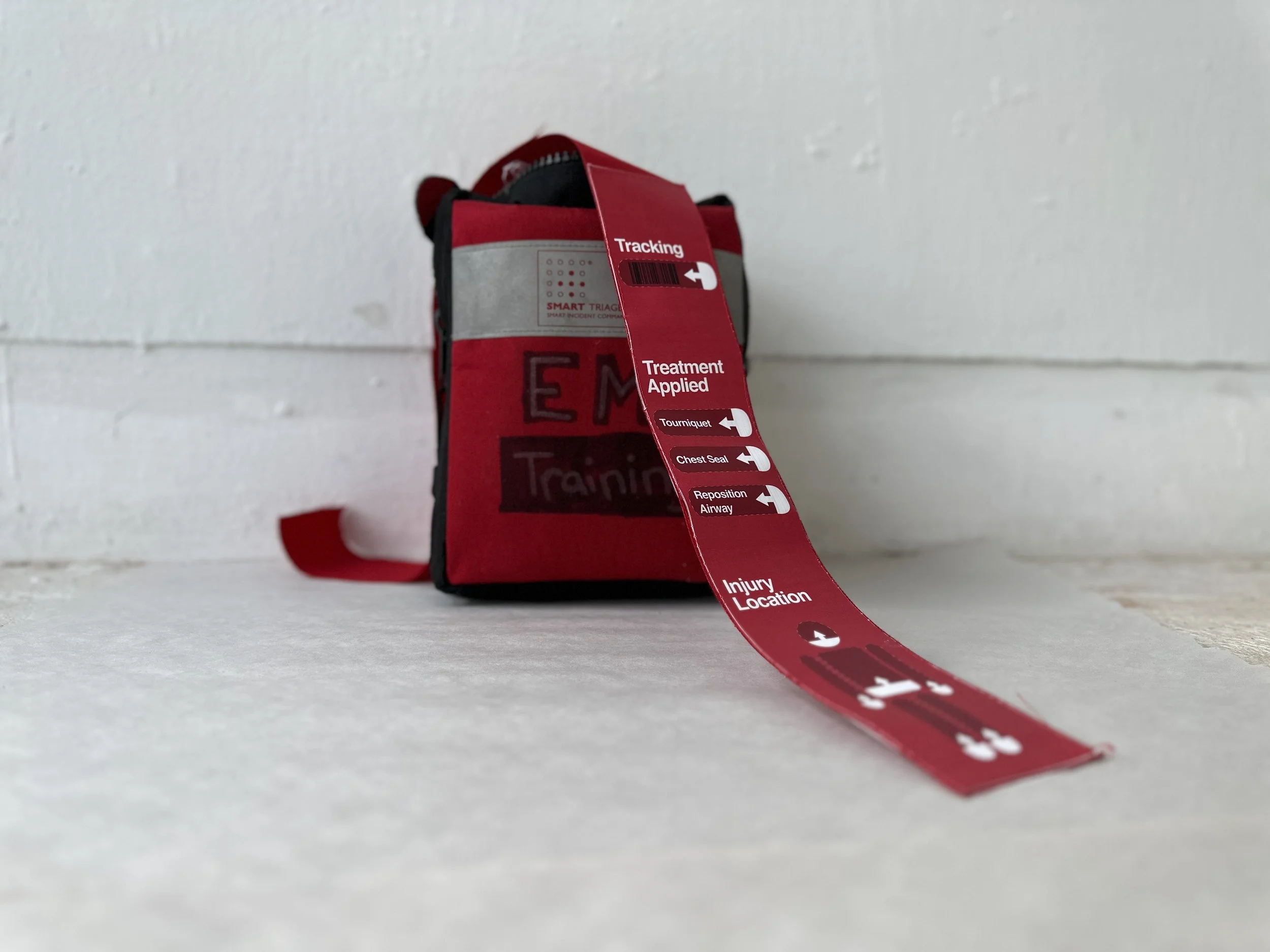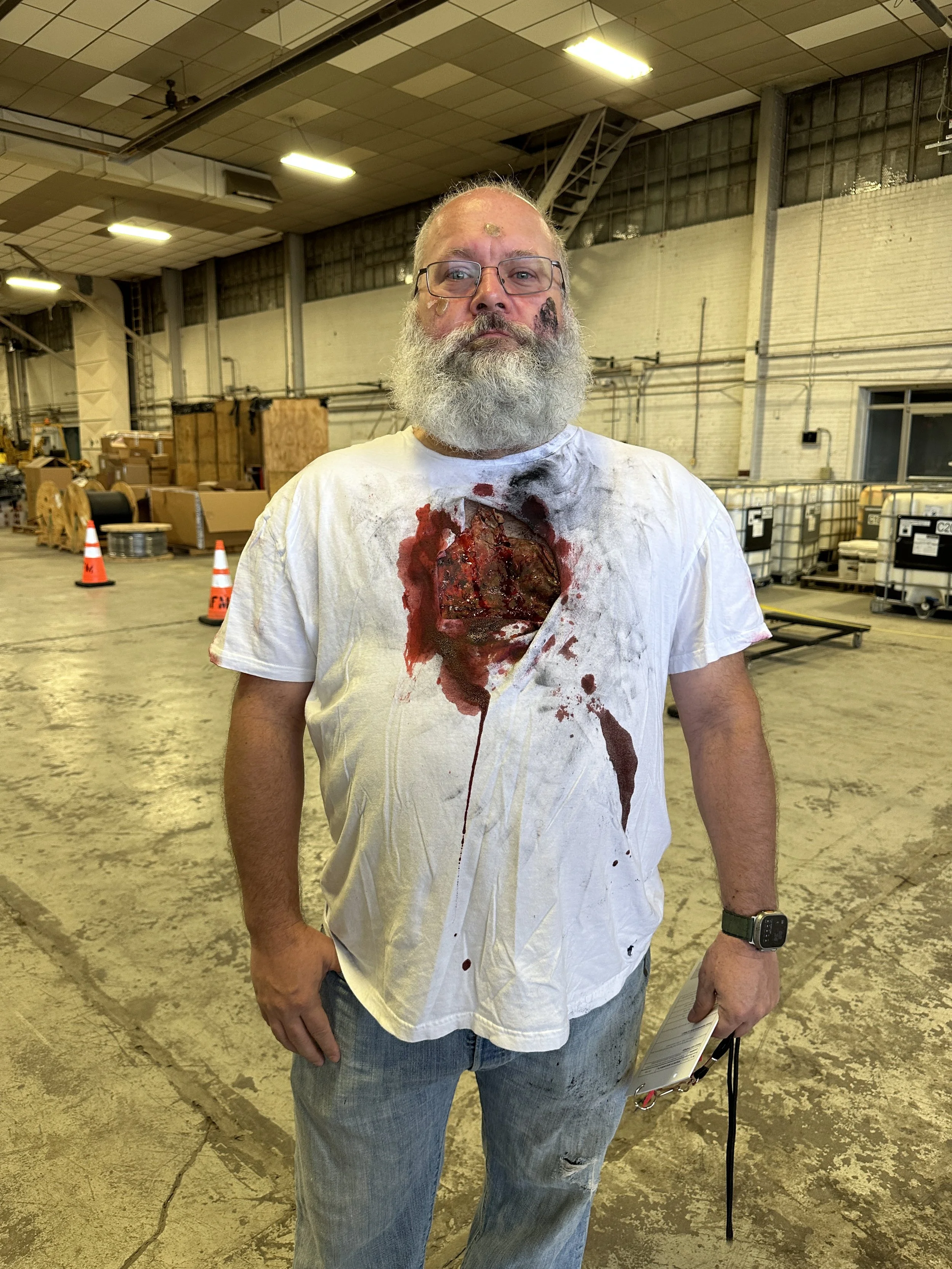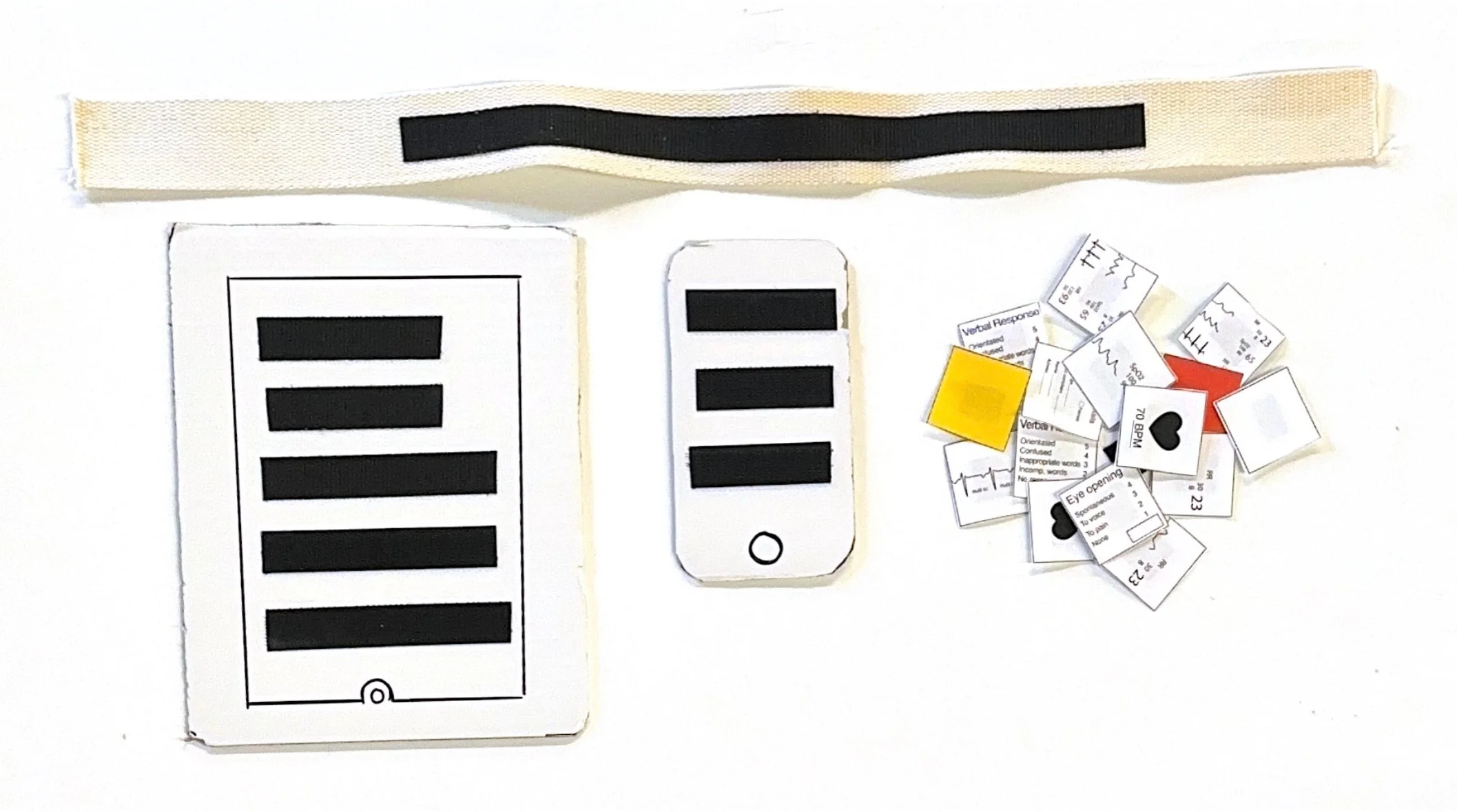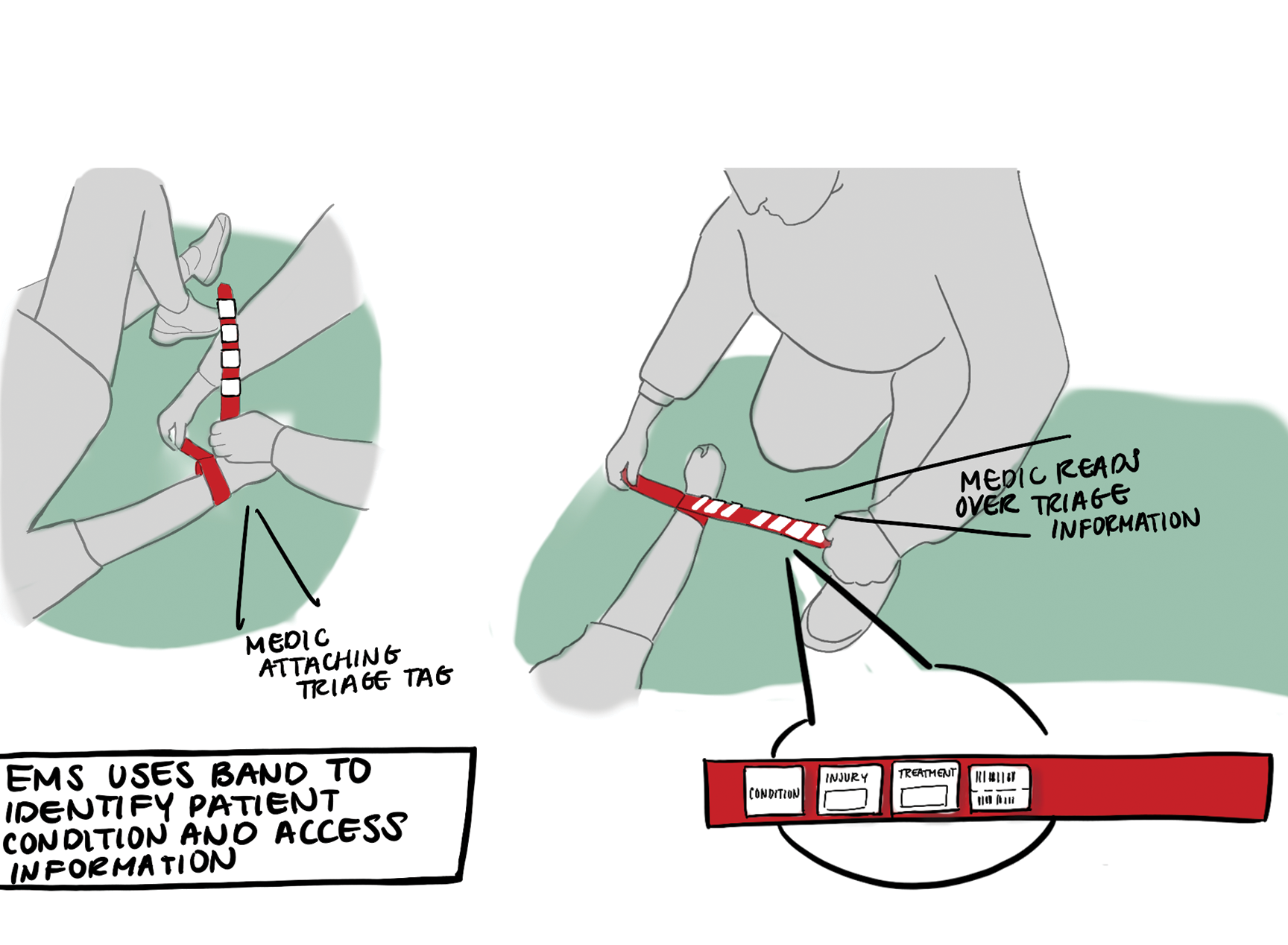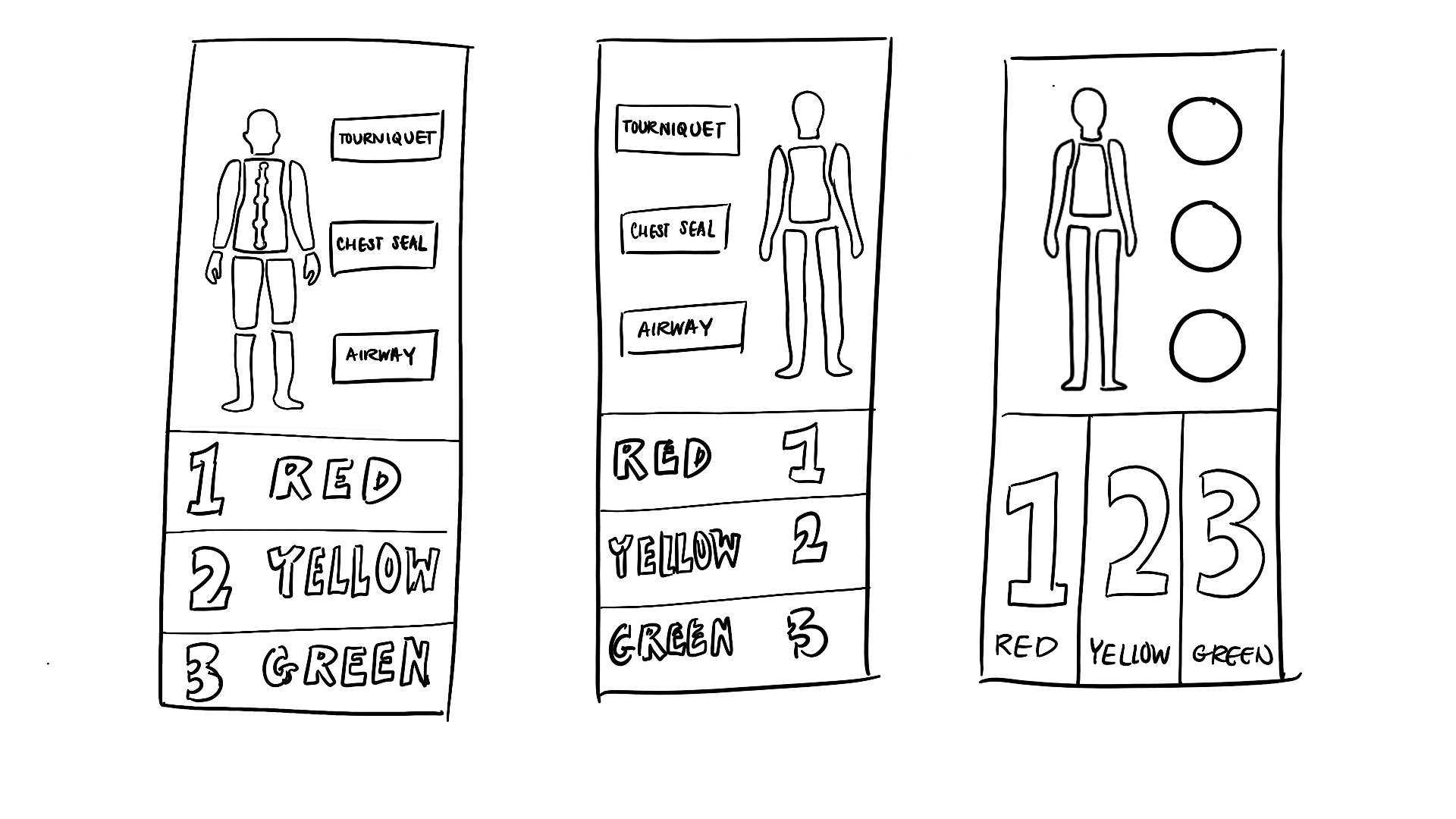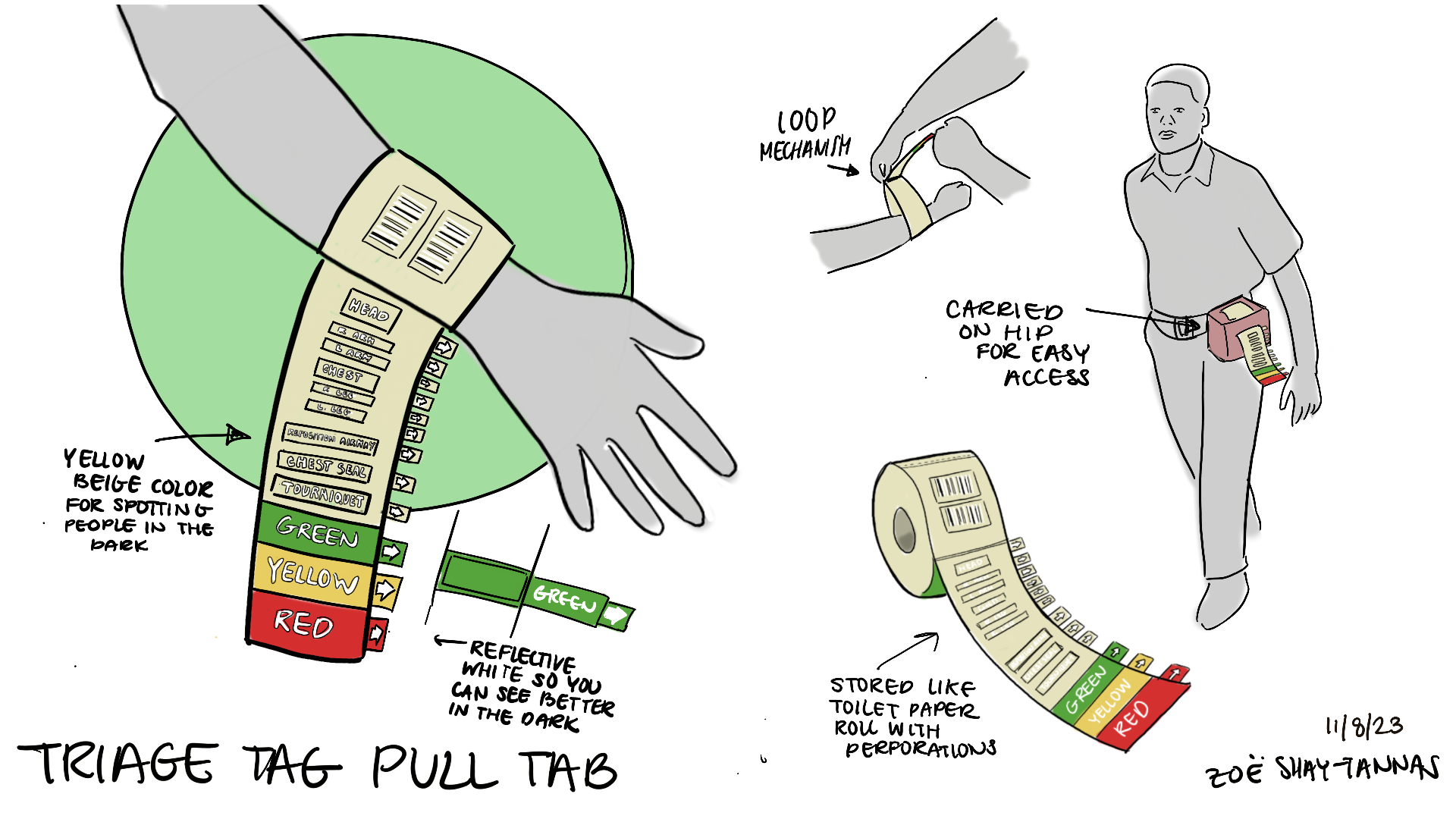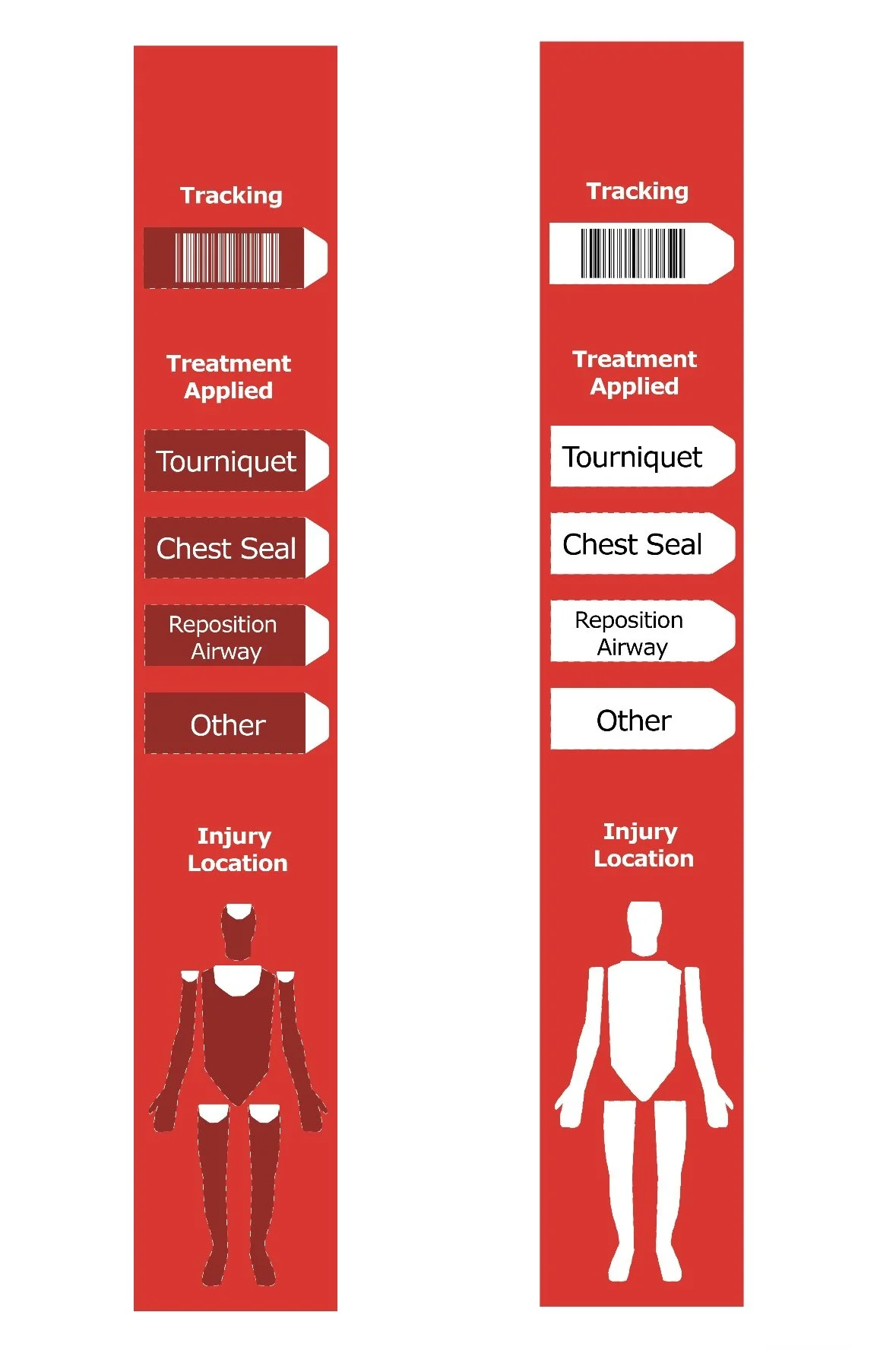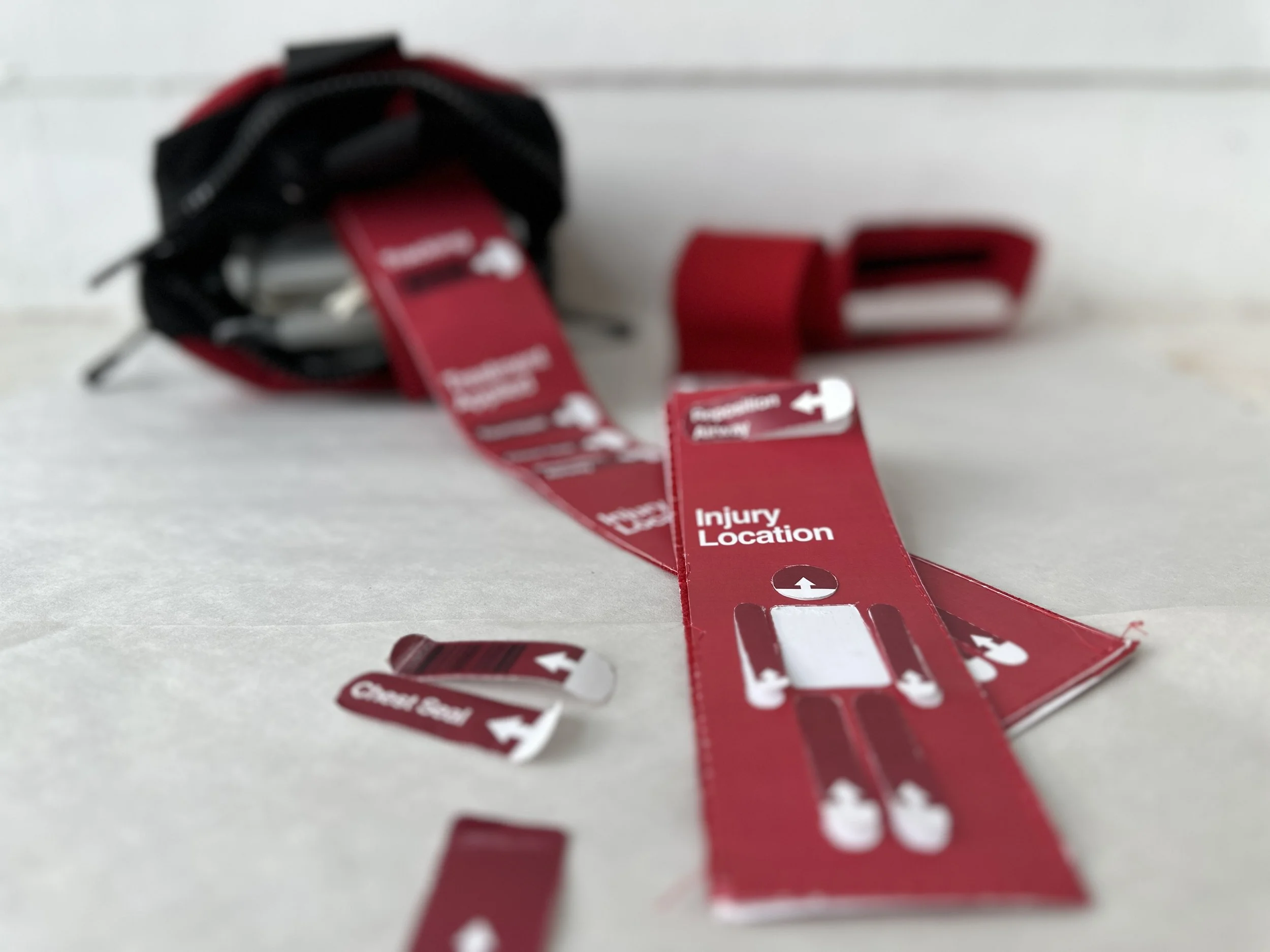
Save a Limb, Save a Life
PullTag
2024 CORE 77 DESIGN STUDENT AWARD WINNER
Commercial Equipment Category
Responding to a Mass Casualty Incident (MCI) is chaotic and often traumatic. Whether it’s a massive highway crash or a wildfire filled with smoke, the environment is unpredictable and overwhelming. In these situations, first responders must track patients and ensure they receive appropriate treatment at the hospital—both critical for survival and essential in the aftermath.
Developed in partnership with Battelle and in collaboration with the Columbus Fire Department, the PullTag™ is an innovative triage tag designed to capture vital patient information without interrupting care. It allows EMS personnel to communicate a patient’s condition clearly and efficiently to others on scene.
Triage is the rapid prioritization of patients based on injury severity. During an MCI, responders have only 30–60 seconds to assess each individual. The PullTag ensures essential data is recorded within that window, without compromising treatment time.
Its pull-tab mechanism eliminates the need for writing in the field. Sections corresponding to injury location, treatment, and tracking are torn off quickly, while more detailed information—like name and date of birth—is included on the back for hospital intake.
In high-stress, unpredictable environments—where it may be dark, rainy, or chaotic—low-tech solutions like the PullTag are often the most reliable. Fewer points of failure. More time to focus on saving lives.
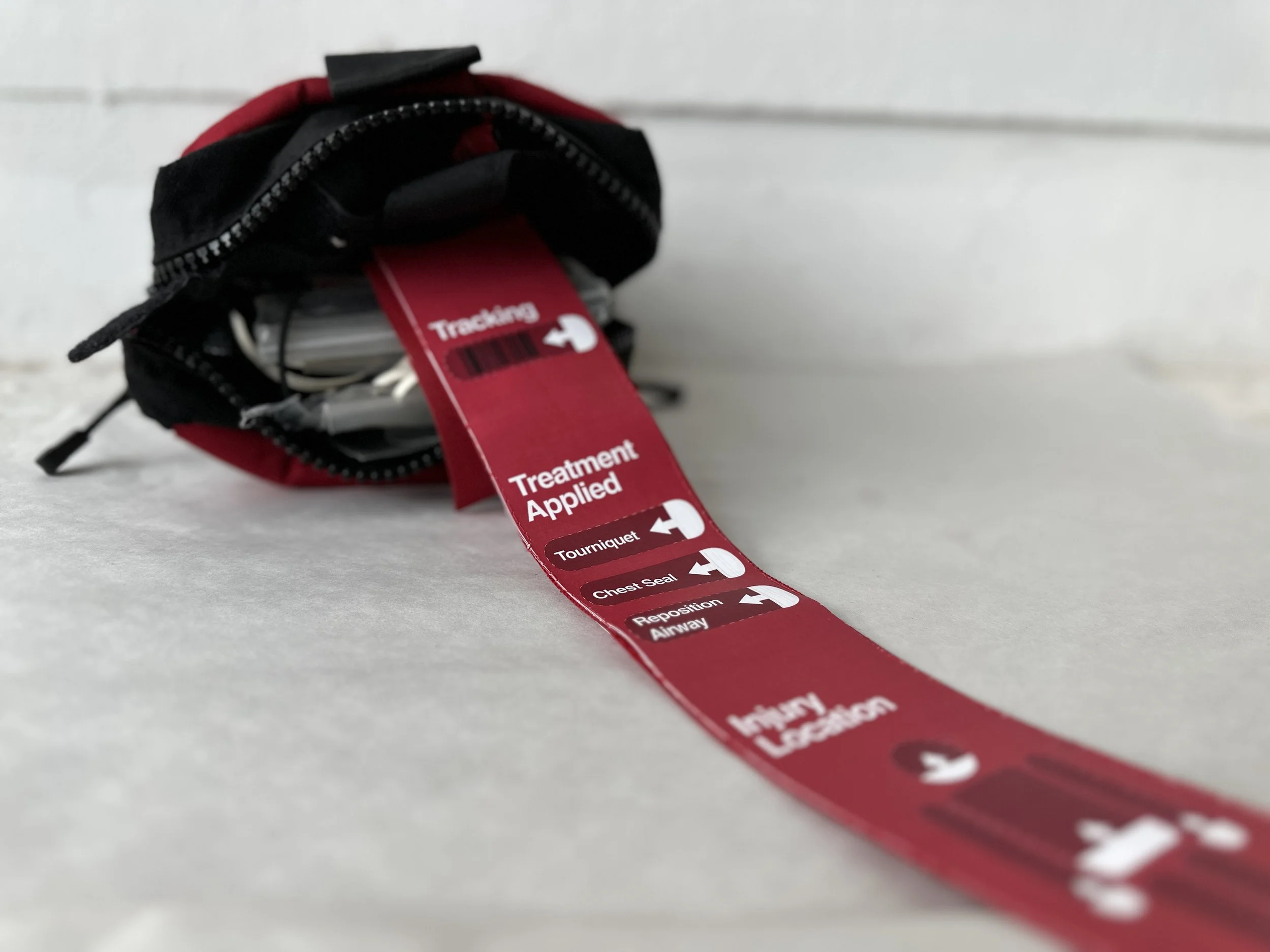
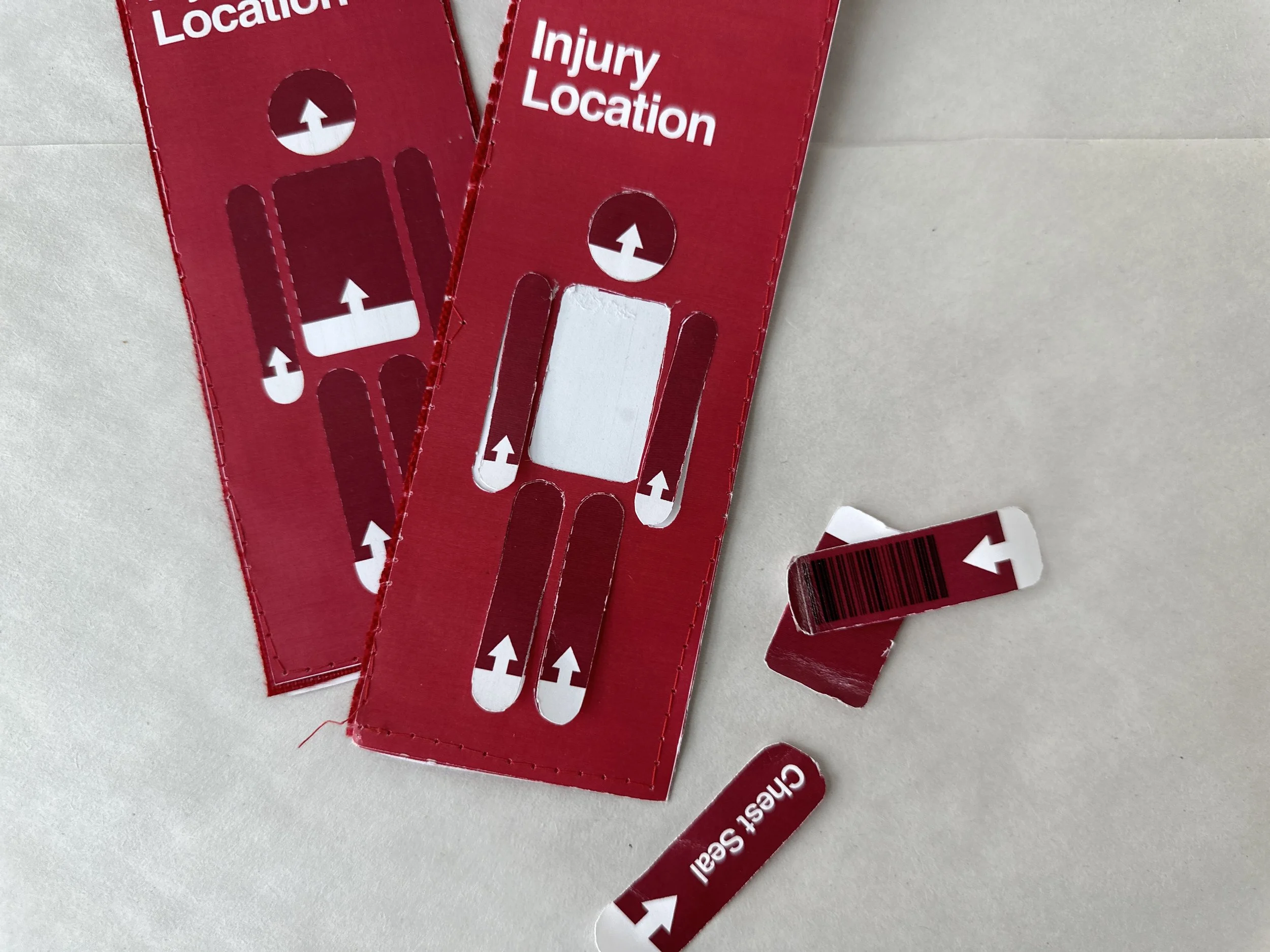
DESIGN CONSTRAINTS
Must design for mass casualty response and transport.
A viable product, a 2-3 minute product video, a process booklet, and a final product poster.
FINAL DELIVERABLES
TIME FRAME
4 months
PRODUCT VIDEO
BLUE SKY RESEARCH
I started to research in different categories such as business, science and technology, and the arts to begin generating initial conjectures.
1 out of 5 conjectures, The Magnet Mover is based on research on science and technology.
It’s based on the idea of having to evacuate many people at one time. EMS personnel would attach a metal band to the patients, then a helicopter would fly over with a giant horseshoe magnet and easily pick up patients on the field.
1 out of 5 conjectures. The magnet mover is based on research on science and technology.CO-DESIGN SESSION #1
Columbus Fire Department
For the frist co-design session, I went to the source: the Columbus Fire Department, in particular R&D.
I asked them to look at the initial ideas. For example, a litter that had GPS tracking on it so EMS could live track patients’ movement after being transported to the hospital. Or, a “guided landing” that allowed EMS to communicate with civilians already on the scene.
Then, I had them rank the ideas on the bullseye. After some long discussions, I realized that communication is essential for the success of a mass casualty response.
Throughout our discussion, everyone kept on coming back as to why the “GPS litter” and “Guided Landing” were on target. The participants relayed to me that keeping track of patients after they triaged them was stressful.
As for the “Guided Landing”, the idea of being able to both visually and verbally communicate would make a world of difference to those who are on scene and those who have not yet arrived.




VISIT TO FIRE STATION #1
I was invited to tour fire station #1 which is the fire station that houses the mock mass casualty vehicle. This was a great experience to better understand the inner workings of a fire station and to meet some more firefighters as well.
The mock mass casualty vehicle that carries all of the equipment needed for an MCI.
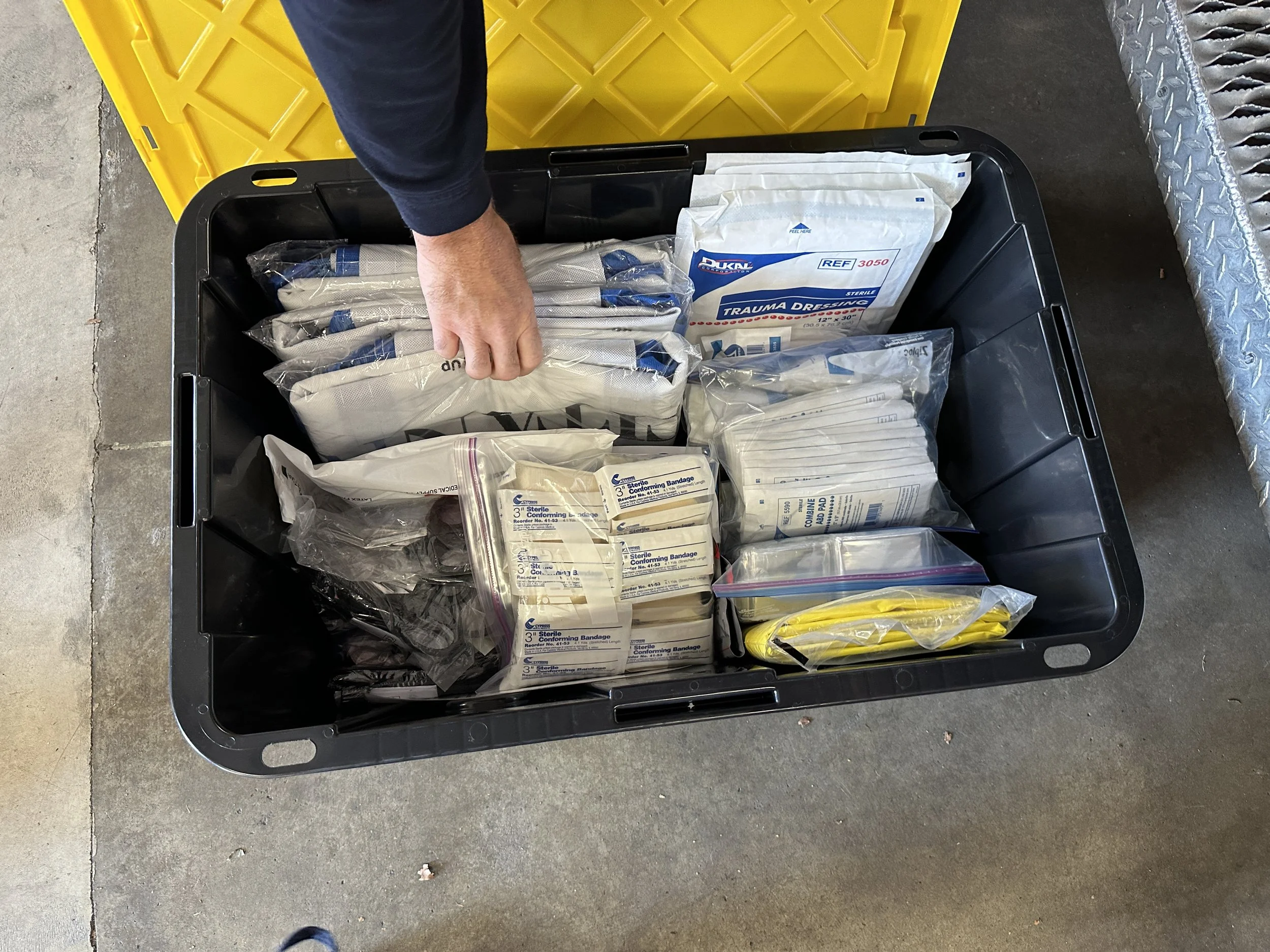
The equipment stored in the MCI vehicle.
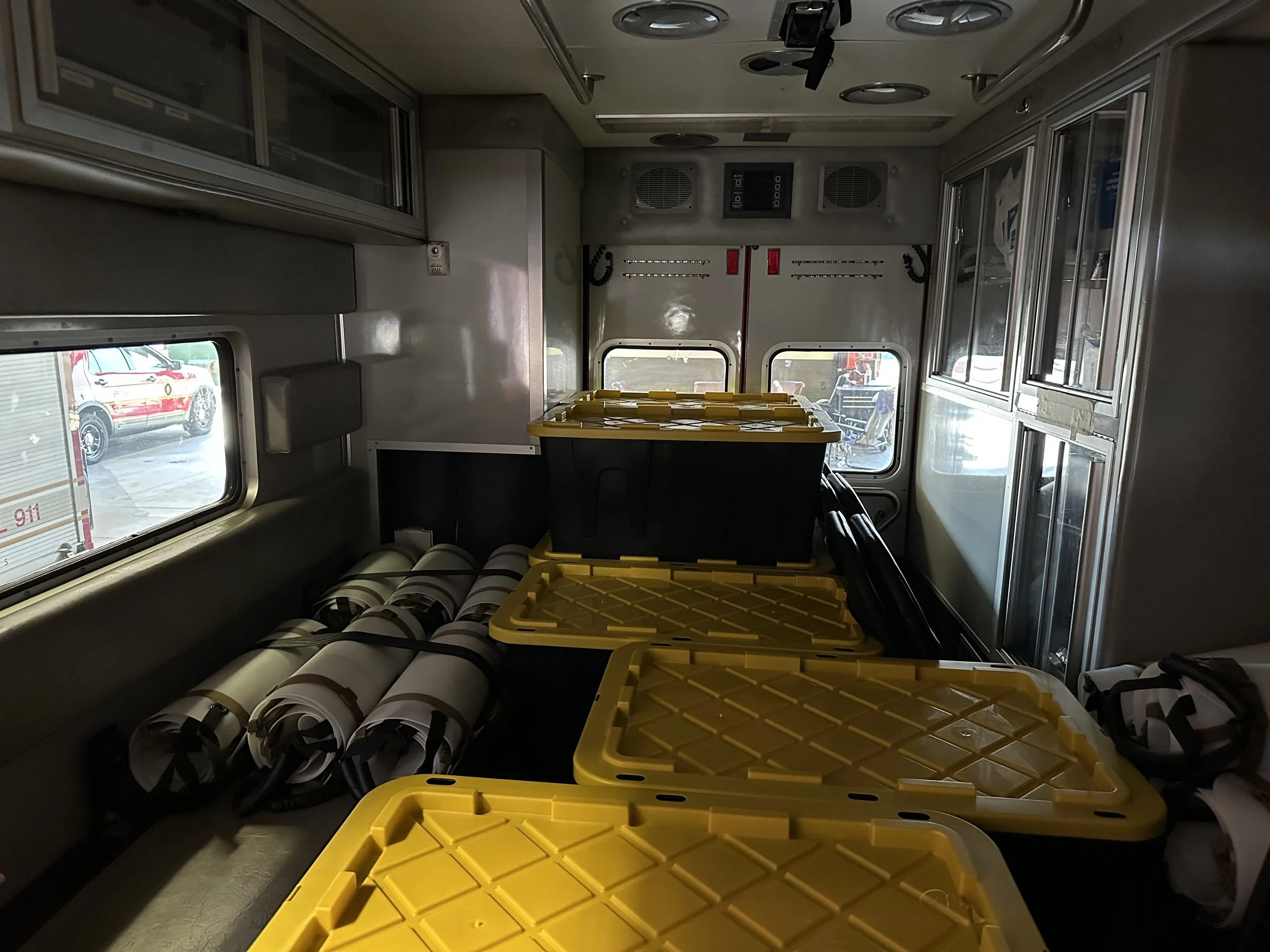
Inside the MCI vehicle.
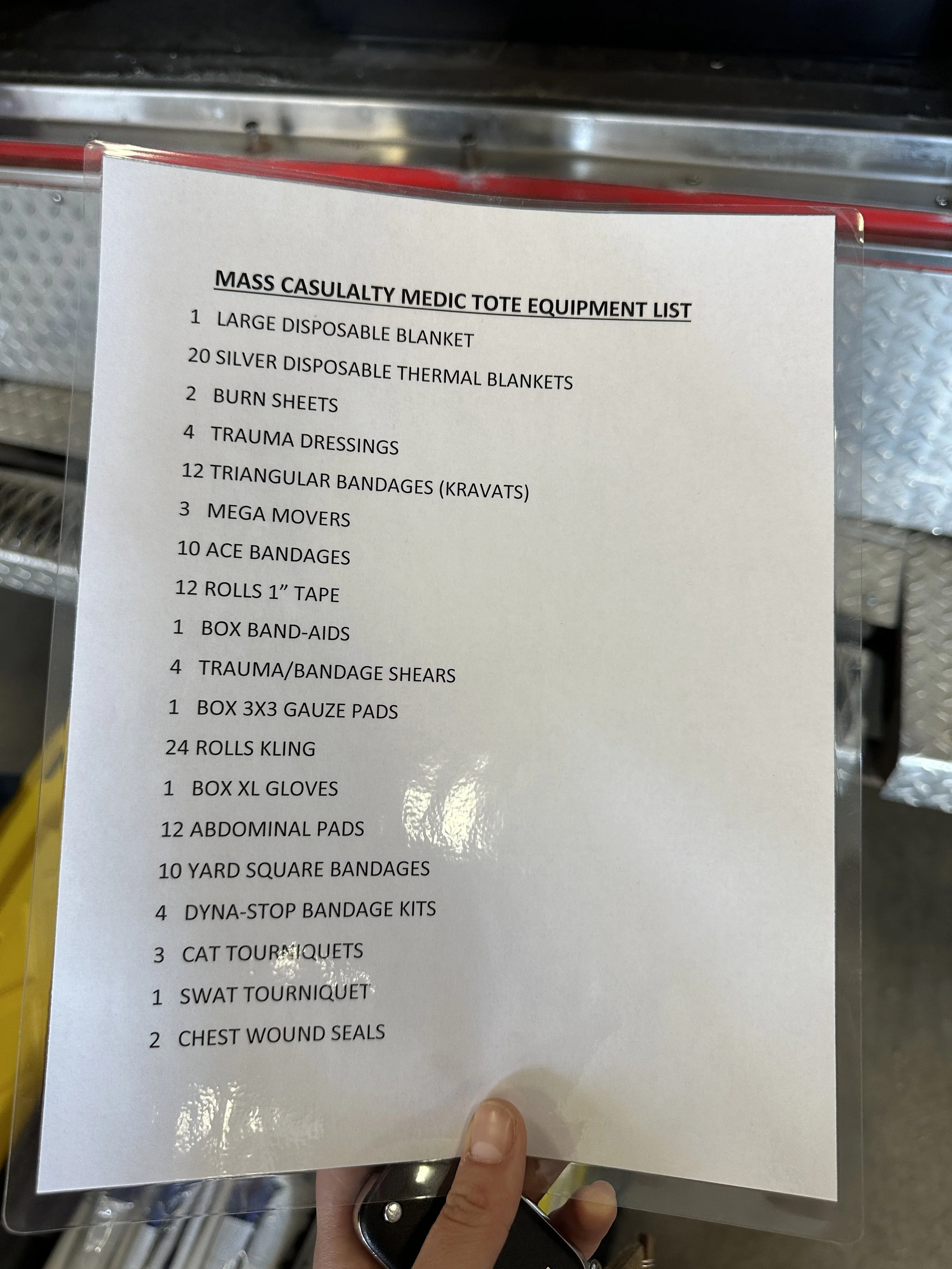
MCI medic tote list.

The XL ambulance.
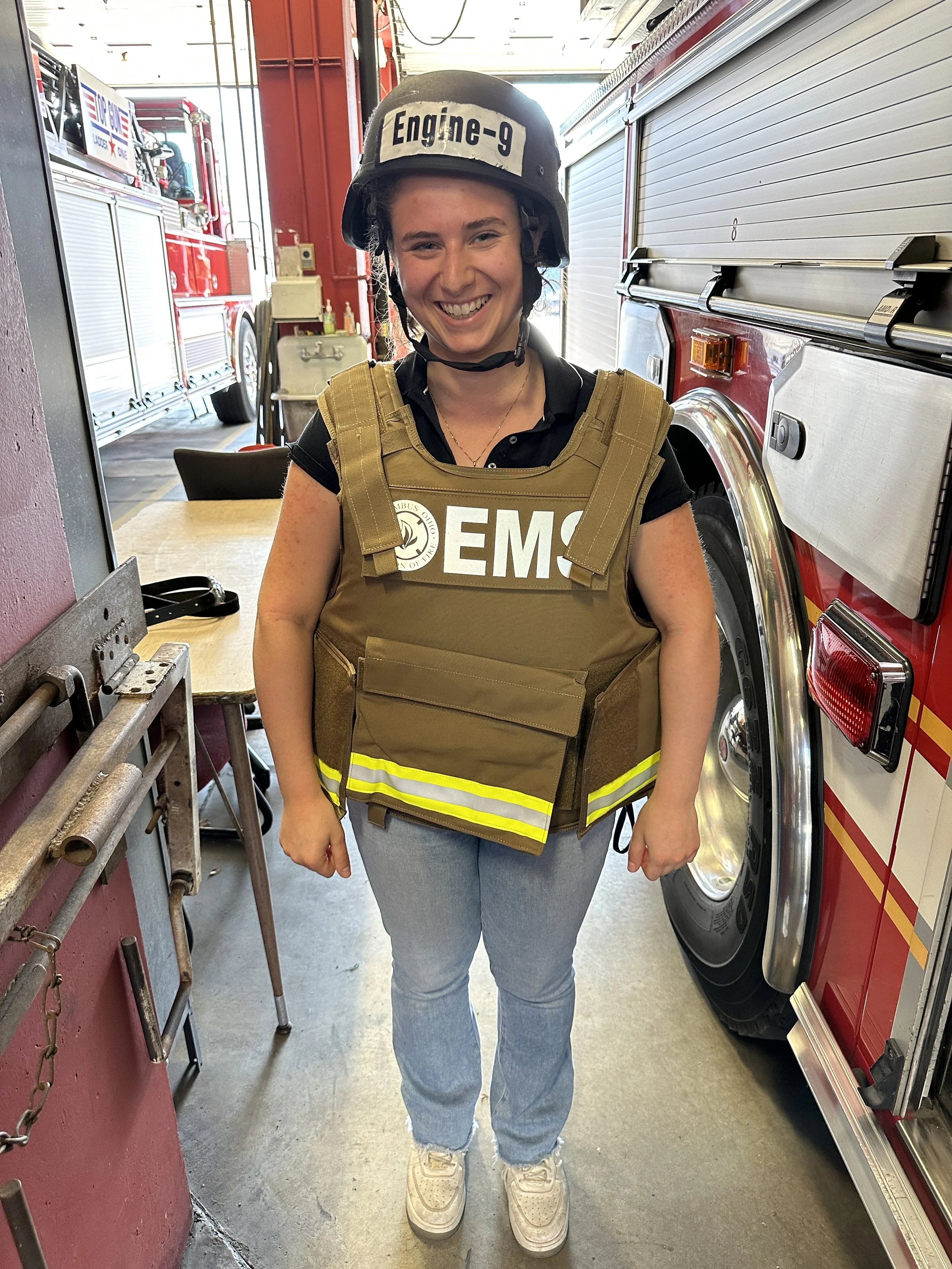
Sporting a ballistic helmet and bulletproof vest.
MOCK MASS CASUALTY TRAINING AT THE COLUMBUS AIRPORT
The CFD Medical Director Invited me to shadow this training, which training included 88 casualty volunteers, EMS responders, firemen, and police officers. The scenario involved a car that crashed into an airplane. After the firemen started a controlled burn, volunteers ran out to different areas of the tarmac. I observed what I had only read about on paper happen in real time.
A lot of the observations confirmed my findings. For example, communication was one of the vital parts to a successful outcome of a mass casualty response.
A volunteer with a fake chest wound.

The controlled burn.

An EMS personnel triaging a patient.
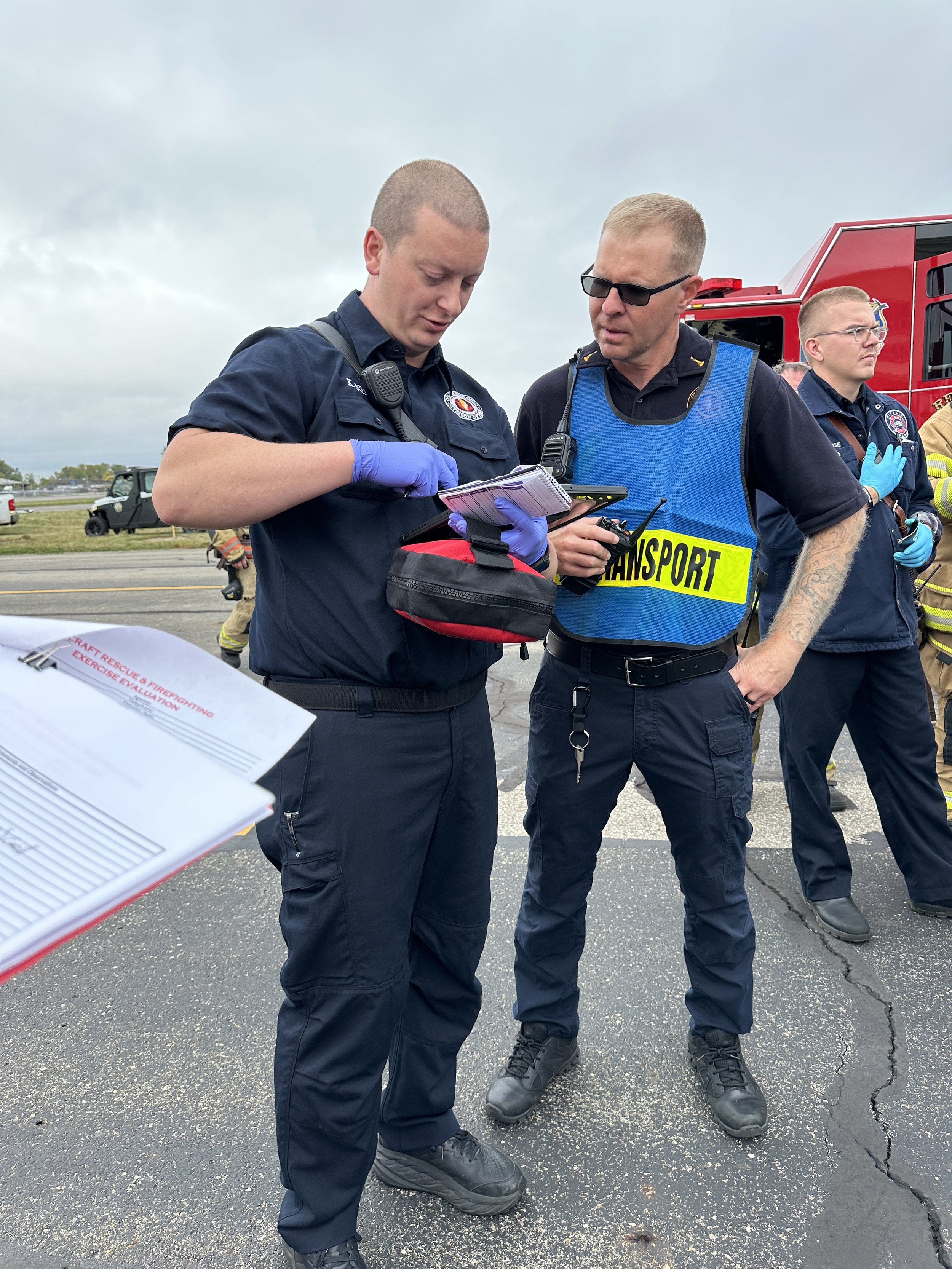
The Transport Commander communicating by radio.

Tablet Command, a platform used to organize MCI patients.
FIRST ITERATION
We brainstormed different ways to communicate in an emergency, then I synthesized all of the ideas.
Visuals were most important in successful communication. The triage tags and ribbons were very visual amidst a sea of chaos. Those cards helped the EMS personnel quickly understand the patient’s condition just by using color.
My initial iterations mainly focused on ways to improve triage tags and track patients, whether that be their vital signs, their location, etc.
I moved forward with a new type of triage tag for EMS personnel to easily keep track of their patients. I tested out the QR code ribbon idea as a formative assessment. However, it took too many steps to access the QR code. Additionally, in different environments like nighttime would add additional obstacles.
Finding themes in the final brainstorm.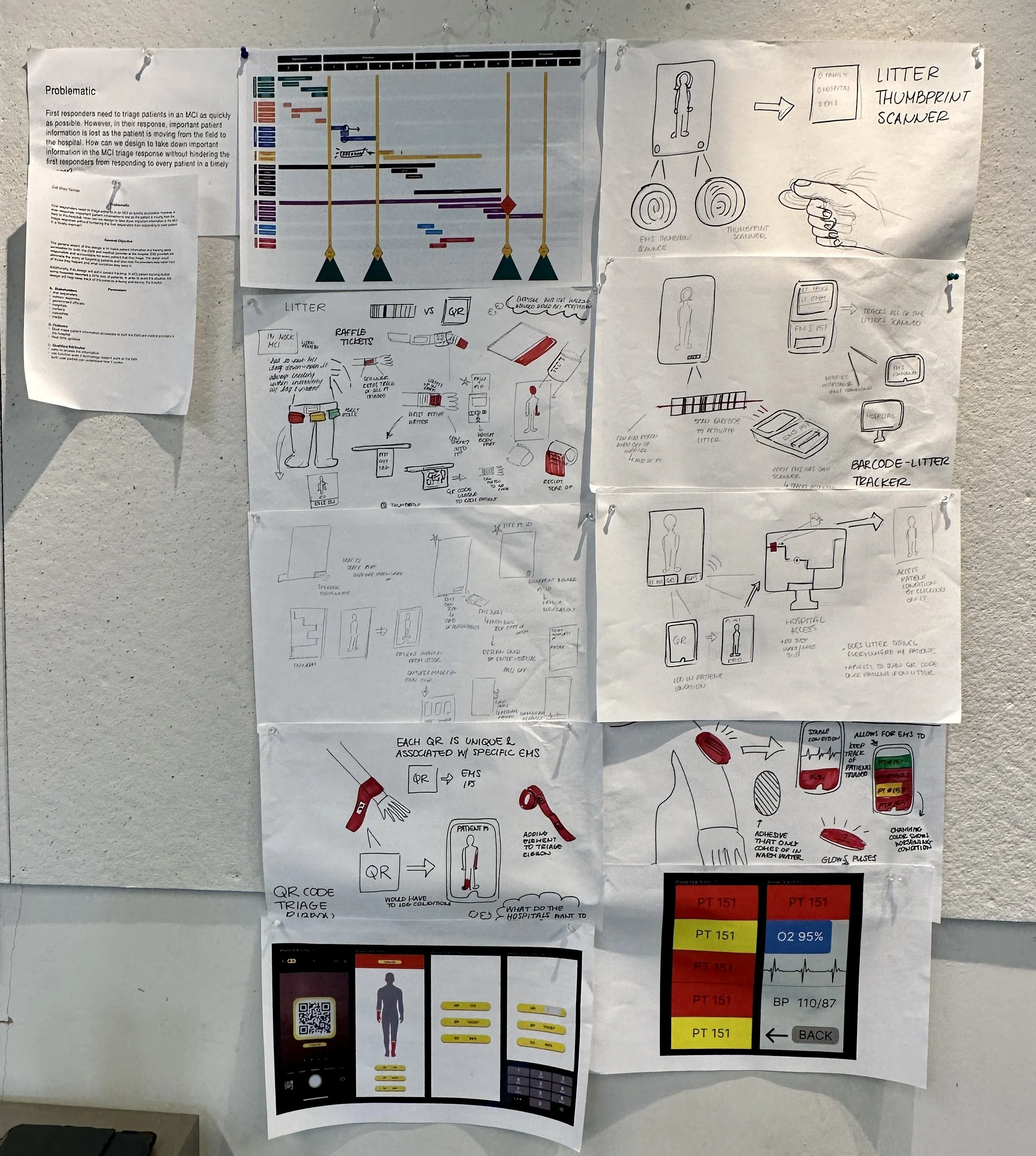
Initial iterations.
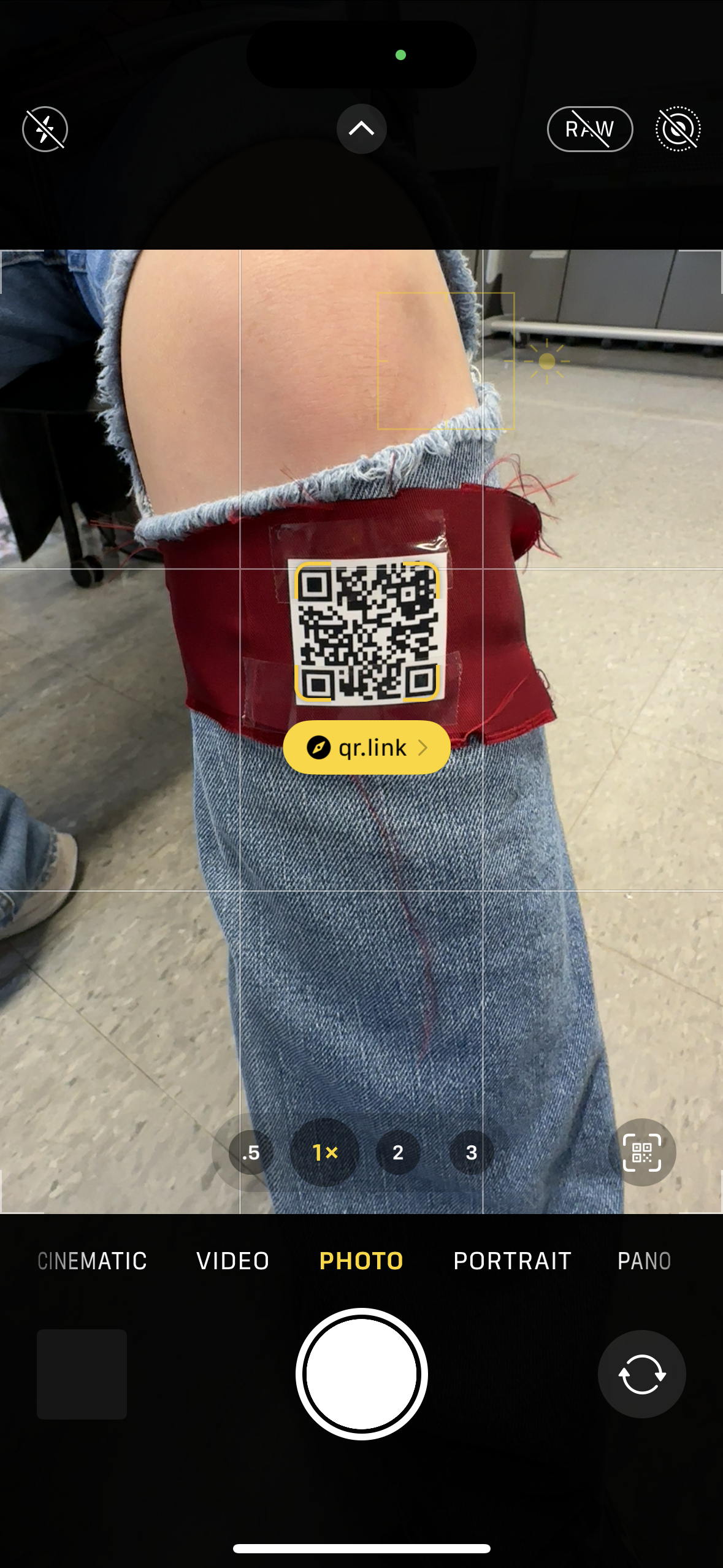
QR prototype.
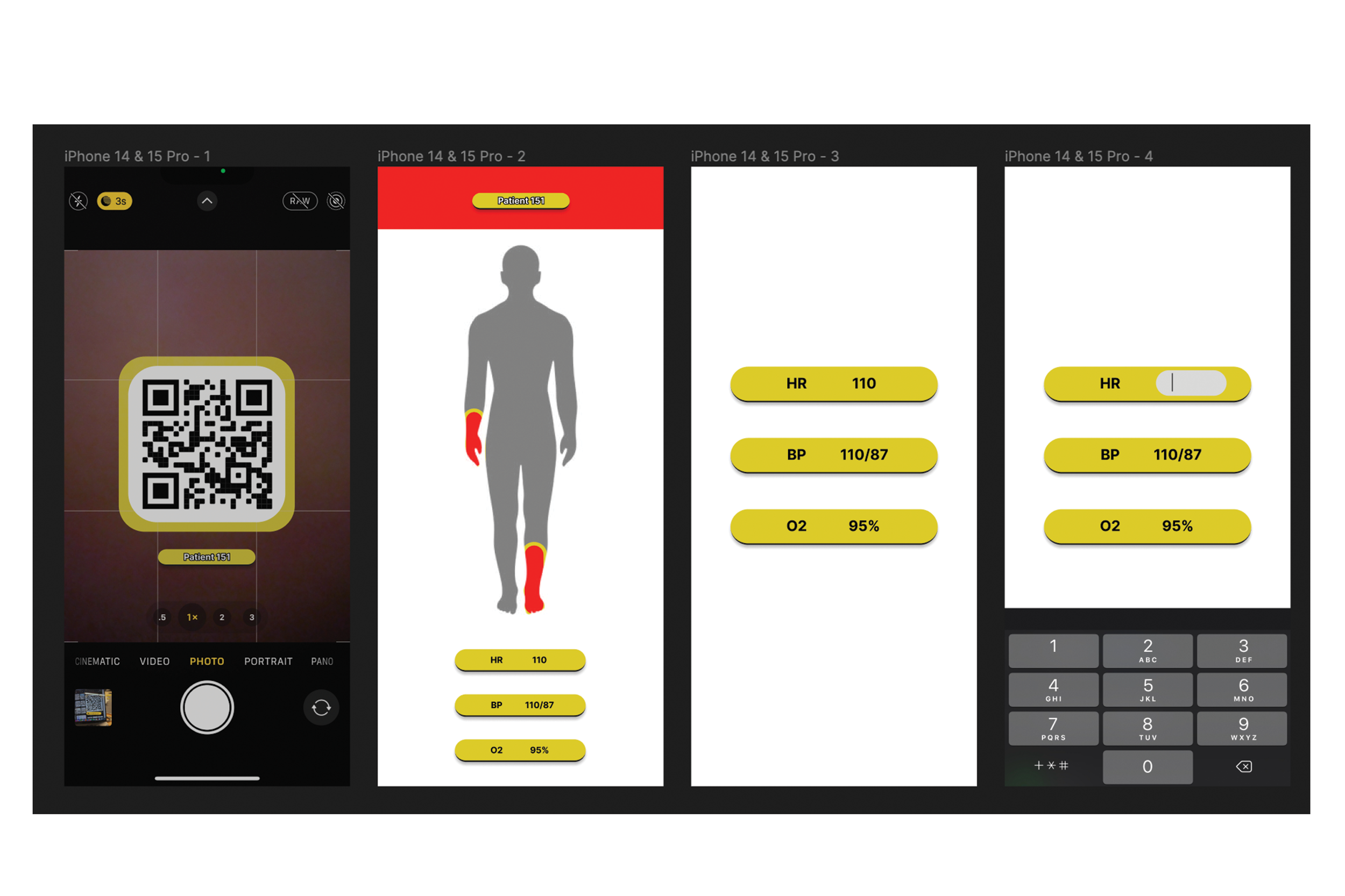
QR phone prototype.
CO-DESIGN SESSION #2
Focused on the triage tag, I conducted a second co-design session where I asked the firemen to create their ideal triage tag. I was interested in learning what kind of patient information was most necessary for triage.
I gave them an empty triage tag with cards that had graphics such as heart rate or patient tracking. I then asked them to attach what they deemed the most vital information. They also emphasized that they wanted to eliminate all writing on the field.
The ideal triage tag eliminated any need to write on the field. EMS personnel wanted to see on the tag which included color, patient injury, patient treatment, and patient tracking. The right of the tag includes information for medical providers at the hospital which includes vitals, patient history, and patient tracking.
The materials I provided to the firefighters which included an empty triage tag, cards with different vital signs, blank cards, two different sized tablets with velcro. SECOND ITERATION
The next iterations included mixes of words and icons. I wanted to make sure that I thought about the best ways to communicate patient condition in an emergency. I determined that words would be the best communicator. Additionally, I asked the medical director which are the most common field treatments so the tag would be as accurate as possible.
Example of how a first responder would use the triage tag in the field. Tag iterations focused on color.
Iterations focusing on orientation, thinking about the best way for EMS to look at it quickly.
Iterations focusing on priority of patient.
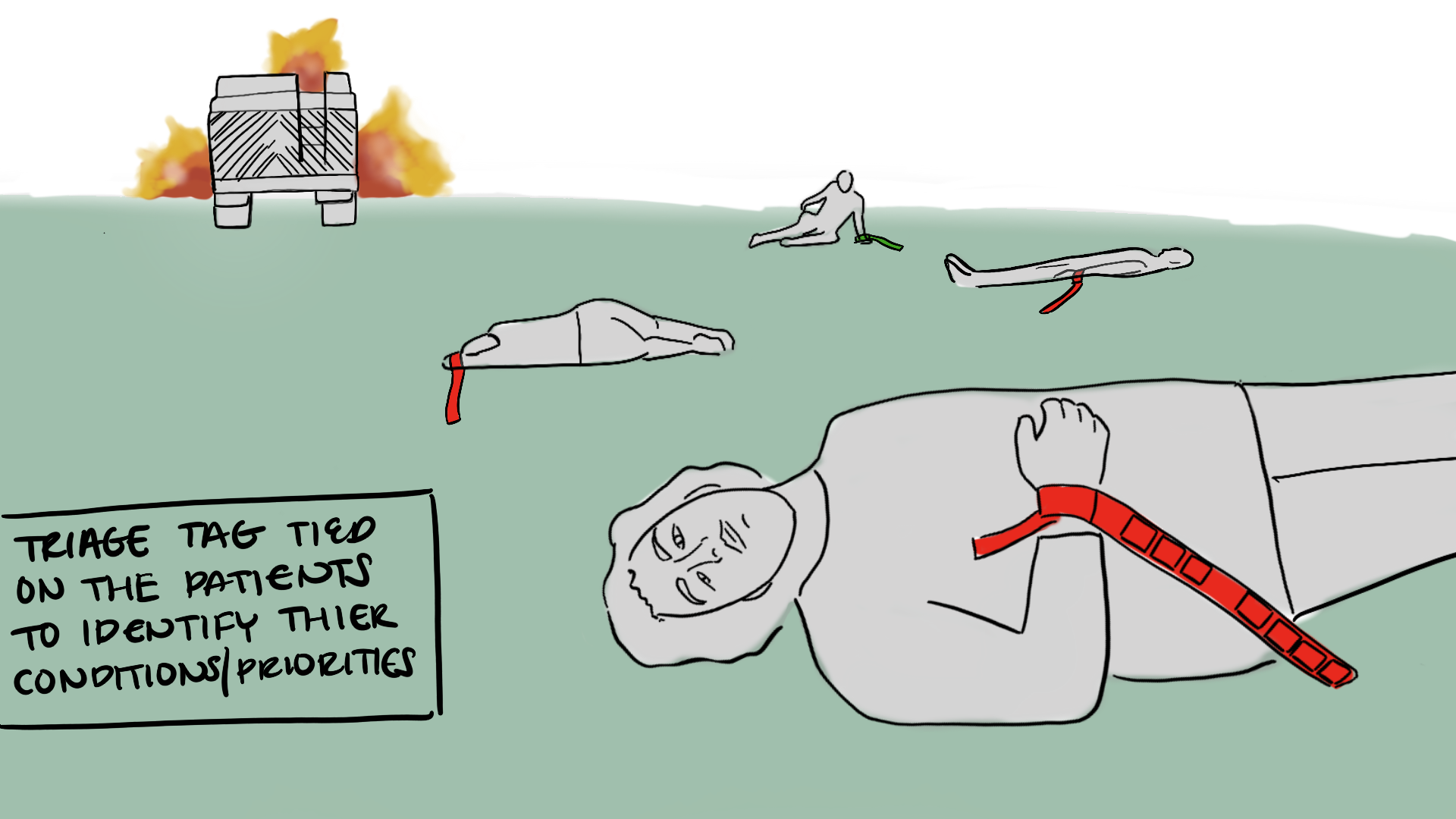
Patient triaged on the ground.

EMS using band to identify the condition of the patient.

ER doctor using the tag to better understand condition when patient arrives at the hospital.
PROTOTYPE TESTING
I gave the firemen one of my prototypes to test out. They used it during one of their training sessions. Below are pictures of fake wounds on different parts of the body. The tag was used with different combinations of treatment and patient injuries.
Overall, it got very positive feedback. There were only a couple of suggested changes. One was adding an “unconscious” and “conscious” tab to “determine the status of the patient at the time of the first evaluation.”
Another suggestion was changing the “reposition airway” tab just to “airway” because “it would give the thought of breathing problems that would need to be addressed if nothing is visible to the eye.” (from an email response).

Initial prototype.

Prototype testing on dummy patient.

Prototype testing on dummy patient.
FINAL REFINEMENTS
I added the final suggestions given by the EMS personnel. I added a “conscious” tab and an “unconscious” tab. Additionally I changed the wording of “reposition airway” to “airway”.
In the future, further refinements can be made regarding the tracking tab. It would be difficult to keep track of a small piece of paper without any container. Therefore, further exploration would be beneficial to design a mechanism to keep track of all the tracking barcodes.
FINAL TRAIGE TAG
The amount of research I did and the amount of time spent on building relationships with the Columbus Fire Department is why this project was so successful. I gained so much valuable insight regarding how EMS personnel operate and how they think, that I designed a product that they would actually use.
It is so simple that it requires very little explanation. One area that needs improvement is how the tracking barcode works. It needs refinement regarding keeping track of the tab one rips off.
Lastly, for this to go into full production, different types of materials need to be used. Tyvek may be a good material for this situation because it is cheap and easy to manufacture.
This design would need to be optimized for mass production. Additionally, triage tags are a one time use item because blood and other bodily fluids often stain the tag. The patients cannot return the tag once it has been used. Therefore, questions arise as to how to make this a more sustainable item in other parts of the production process.
Additionally, the rip off tabs may be an issue for mass production and may not work with the final material. However, I am very pleased with the final outcome.
Contact me.
z.shaytannas@gmail.com
(617) 477-7602
Dallas | TX
